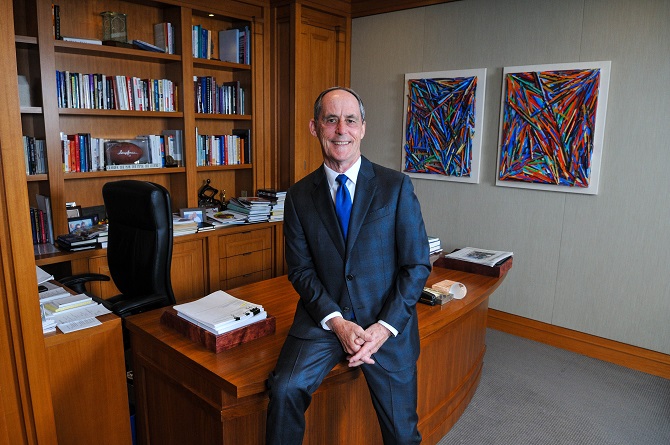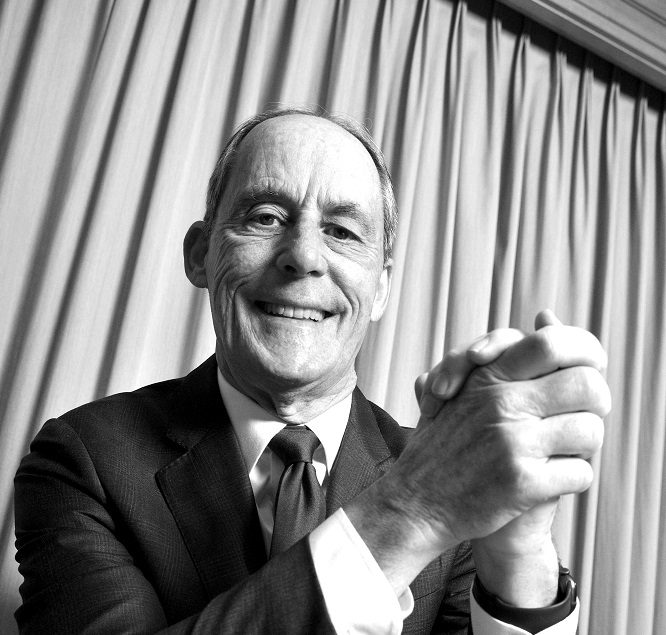As chief executive and president of Cedars-Sinai Health System, Thomas Priselac heads the largest hospital complex not just in Los Angeles County but in the Western United States.
The flagship hospital, Cedars-Sinai Medical Center, has 886 licensed beds, more than 2,100 physicians and more than 14,700 full-time employees. The 2017-2018 fiscal year saw more than 50,000 patient admissions, nearly 800,000 outpatient visits and 91,000 emergency room visits.
Cedars-Sinai also operates Marina del Rey Hospital, with another 133 beds and more than 500 employees. And with Providence St. Joseph Health, Cedars jointly manages the Tarzana Medical Center, with another 249 beds. Cedars also is affiliated with the 533-bed Torrance Memorial Medical Center.
For the fiscal year ending in June 2018, Cedars-Sinai had total revenue of nearly $3.5 billion and a budget topping $3.1 billion.

Priselac, 68, has had a long executive career at Cedars-Sinai, joining the hospital 40 years ago and becoming president and chief executive in 1994.
Prior to Cedars, he was on the executive staff of Montefiore Hospital in Pittsburgh. He earned a bachelor’s degree in biology from Washington and Jefferson College in Pennsylvania, and a master’s degree in public health, health services administration and planning from the University of Pittsburgh.
Priselac is an adjunct professor at the UCLA Fielding School of Public Health and is a board member of the Charles R. Drew University of Medicine and Science. He also serves on the boards of numerous civic organizations, including the Los Angeles Area Chamber of Commerce and the Los Angeles County Economic Development Corp.
Cedars-Sinai is far and away the top-ranked hospital in Los Angeles County by both the number of staffed beds and by net patient revenue. What is Cedars doing to maintain that top ranking?
Being the biggest has never been one of Cedars-Sinai’s goals. Our goal has and always will be striving for excellence in all we do to fulfill our mission.
The key to our success is our people — the physicians, nurses and all the other staff as well as our 3,000 volunteers. Our focus is on supporting them in every way possible, enabling them to do what they do best in the interest of our patients and the community.
Nonetheless, Cedars-Sinai has been on an expansion drive for several years now. What’s the strategy behind this effort and what’s the end goal?
Throughout Southern California, people tell us that they would like to have Cedars-Sinai-quality care available closer to where they live and work. And we also have been getting a lot of interest from other health care organizations and physicians in the region who want to affiliate with us in a variety of ways.
By expanding our accessibility, we are able to better meet our mission — serving the health care needs of Southern California — and offer more coordinated care throughout the region.
What were the major moves that Cedars made in 2019?
While many people still think of Cedars-Sinai just in terms of our flagship hospital, the reality is that we now offer both primary and specialty physician services in locations throughout the region.
In addition, our affiliation with Torrance Memorial (entered into in 2018 and expanded in 2019) and our joint venture in the Providence Cedars-Sinai Tarzana Medical Center provide more ways for the public to benefit from Cedars-Sinai care.
We also recently announced that we will be rebuilding the Marina del Rey Hospital facility over the next several years so that it can better serve the community.
What other moves did Cedars-Sinai make in 2019?
We continued to expand our community benefit programs to increase access to health care in underserved communities throughout Los Angeles. For example, our Community Clinic Initiative provides grants and training to strengthen those crucial organizations, and our Behavioral Health Initiative provides financial support to 26 community organizations that provide direct mental health services.
And our Healthy Habits program offers ongoing health education and exercise programs at more than 30 Head Start and elementary school locations in underserved areas of Los Angeles.
Any expansion plans on tap for 2020?
We are continually asking ourselves how we can better meet the needs of the community. Sometimes that may be accomplished through geographic expansion (or) through an affiliation with another organization. At other times it may be accomplished through strengthening our existing facilities and programs.
For example, our medical research and education programs — developing new treatments and training the next generations of health care professionals — grew significantly in 2019 and will continue to expand in 2020.
What are some of your other goals for Cedars in the coming year?
While providing the best quality care will always be our primary goal, we are also committed to doing all we can to address the cost of health care.
In addition, there is increasing interest in using “virtual visit” technology to make care even more accessible. We have made big strides in all of these areas over the past several years and will continue to focus on them in 2020 and beyond.
You mentioned the cost of health care. What steps is Cedars planning to contain costs?
At Cedars, we are engaged in a continual reexamination of our processes and practices to identify simpler ways to provide the highest quality care for our patients.
One of those is using economies of scale — due to our expansion and affiliations — to lower our costs for pharmaceuticals, medical technology and other costly items. Another is continued use of technology to better coordinate care for patients, including electronic medical records and “virtual visits” for patients from their smartphone or laptop.
The Cedars-Sinai Accelerator is now hosting its fifth class of entrepreneurs. Why did Cedars create this program and what do you hope will emerge from it?
Solving health care challenges requires innovation, which has always been part of Cedars-Sinai’s history and culture. The Cedars-Sinai Accelerator brings innovative early-stage tech companies to Cedars-Sinai to work with our staff, so they can refine their products to best meet the needs of clinicians and patients. Our goal is to help bring useful technological solutions to improve health.

As Cedars-Sinai has continued to expand, there’s been huge growth in medical office space use in Beverly Hills and the Beverly Grove section of Los Angeles. Are you concerned that the growth in the number of physicians with ties to Cedars-Sinai could outstrip the ability of those communities to provide adequate medical office space?
The demand for medical office space reflects the growing public demand for health care services more broadly as the population ages and more people have coverage. We are doing our best to make sure our facilities are as efficient as possible.

